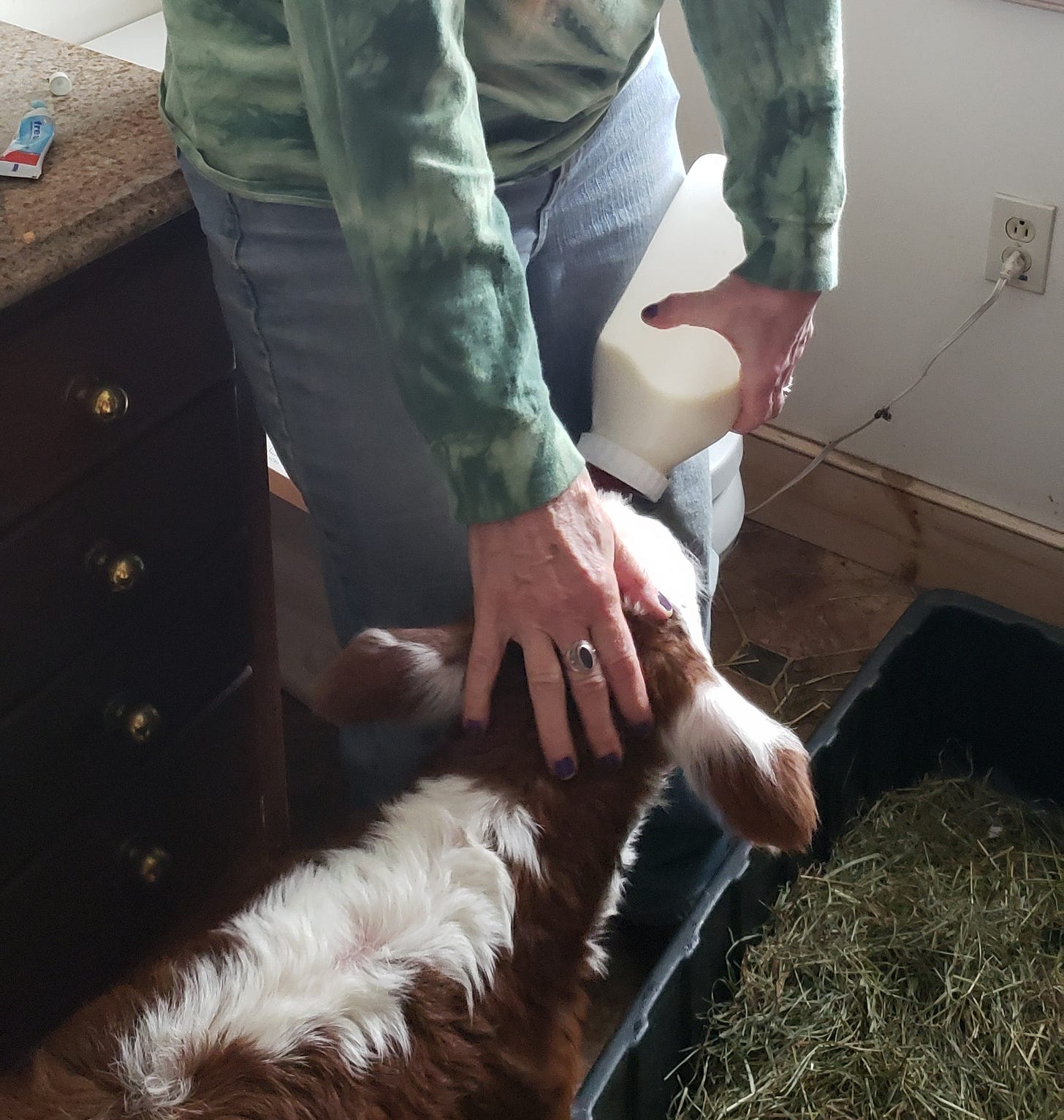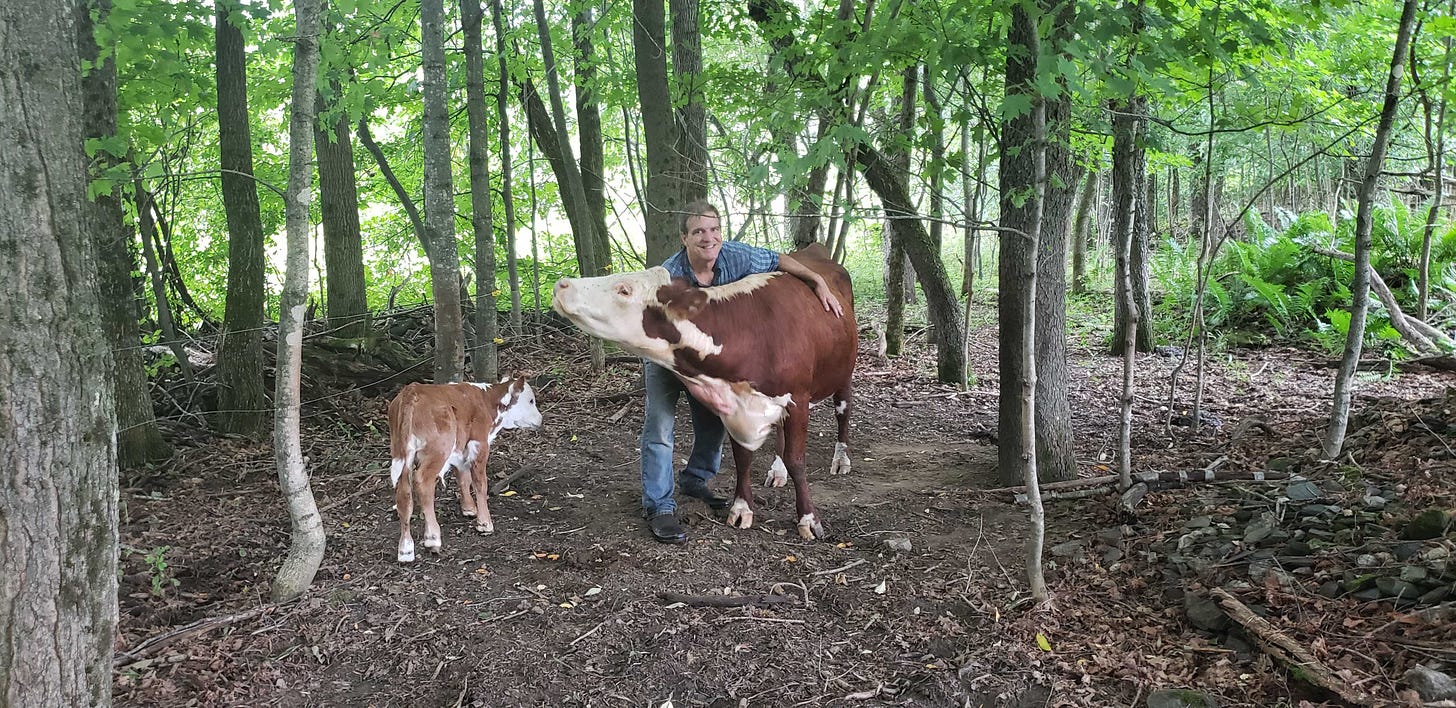Farming is about hard work and adversity, and the tremendous rewards that only come from both. This is a true story about a calf named Mary, and the obstacles that she (and we) overcame to help her become a cow.
The first lesson in this story begins with a bull named Deisel. After a brief period without cows, we bought three yearling heifers in 2020, and that fall, it was time to breed them. That year, Hereford bulls were in short supply. I called one farmer who had two for sale — just posted on craigslist — and he told me he had sold both in one day. I asked him if he had any others and he said he had a younger bull who he thought would serve. Hos name was Deisel: we brought him home.
But Deisel was not quite mature enough for the task — yet. And so he bred the cows late, and we had calves in winter: not something we would deliberately choose to do. (As an aside, last winter we had a young bull of our own named Phantom, and we were concerned we would repeat the problem, so we bought a mature bull to join him. As it turned out, Phantom had already bred all the cows and we carried the extra cost of a bull all winter for naught).
And so one day in early March of 2022, I found a newborn calf laying in the snow at about 4 PM. It had been a nasty cold snap, and she had already lost suck. (Meaning, she was stiffening up and had lost the “suck” reflex — even if I held her mouth on her mother’s teat, she wouldn’t suck or drink. This is sure death for all newborns, so I hoisted her up and brought her in the house and laid her in a firewood sled in the bathroom.
This presented a number of issues. It is generally agreed that farmers should avoid bringing newborns into the house — once accustomed, it becomes very difficult to return them to the outdoors temperatures. Bringing the calf inside was likely a decision to bottle feed it — more work and money, and not best for the calf. But the first task was to keep her alive.
The immediate need was to get milk in her. There were only two ways this was going to happen: she would warm up and ragin suck and we’d get her on her Mom, or she was too far gone and we would have to “tube” her. Tubing involves a plastic bag connected to a two-foot plastic tube that can be slipped down a calf’s throat. A clamp is loosened and the bag contents are dispensed to the rumen. Much like an IV bag for humans, this can be used for milk replacer, or cow’s milk, and can be complimented with probiotics (with sick calves, electrolytes and perhaps an egg can be added to firm them up and reverse scours, but that is a substack for another day.)
Being late in the day, I suggested to my wife Jackie that we had best go to Tractor Supply and pick up a tubing kit in case we needed it, and we visited a local farmer for some raw Jersey milk from his bulk tank. I told Jackie that when we got home, we’d either have to tube the heifer or she would be looking up in anticipation. Fortunately, it was the latter — when I timidly peered into the bathroom when we got home, she was bright-eyed and sitting up, curious about her strange surroundings.
Instead of the tube, she got a warm bottle of raw Jersey milk — seen here:
(Mary gets her first taste of milk, in the bathroom!)
Subscribe to Small Farm Republic to unlock the rest.
Become a paying subscriber of Small Farm Republic to get access to this post and other subscriber-only content.
We were hardly out of the woods, though. We named her “Mary,” and planned our next steps. Calves must have colostrum, especially for the first three days of their lives, or there is a high chance they will drop dead weeks or months later. We needed to get Mary back on her mom (Brindy) ASAP. but the temps were plummeting again that night and we were skeptical Mary would make it.
And so we kept her in the bathroom, where she was immediately walking around. We gave her a bottle every 8 hours, and in the morning as the day warmed we brought her out to her Mom, who stood for her and let her get her colostrum. For three days, we brought Mary in at night and supplemented her with Jersey milk, then left her on her mom through the day. We also borrowed a calf coat from another dairy farmer, and Mary got her own jacket! By day four, the temps had subsided and we moved mother and calf into a small shed and left her with her jacket — no more calf bathroom Airbnb!
Mary did very well, and was quite a rambunctious young girl. Yet two years later it was her turn. This July, we walked out to the pasture to find Mary had a calf of her own — a bull that I immediately named “Liam” for obvious reasons. Of course, her sting in our human bathroom, and my tender care of her daily, mean that Mary id fully domesticated, as can be seen here:
(Mary with her newborn bull calf, Liam.)
Liam is growing fast. Perhaps he will be our future herd sire, or perhaps we will eat him. In the meantime, mother and baby are enjoying their winter hay. They have a good life…..







So heartening - thanks for sharing this experience!
Thank you so much for this! I was hoping you’d tell a tale from your farm. The stories are soothing in a tumultuous time. Thanks for the photos, too! I read that a dairy farm overseas offers “cow hugging sessions”. I would definitely pay for that! I worked on a couple of ranches and went through calving season. It’s a magical and rather stressful time. I learned that most things happen in the middle of the night, during blizzards. So worthwhile, though. Again, this was EPIC!!! Thank you!